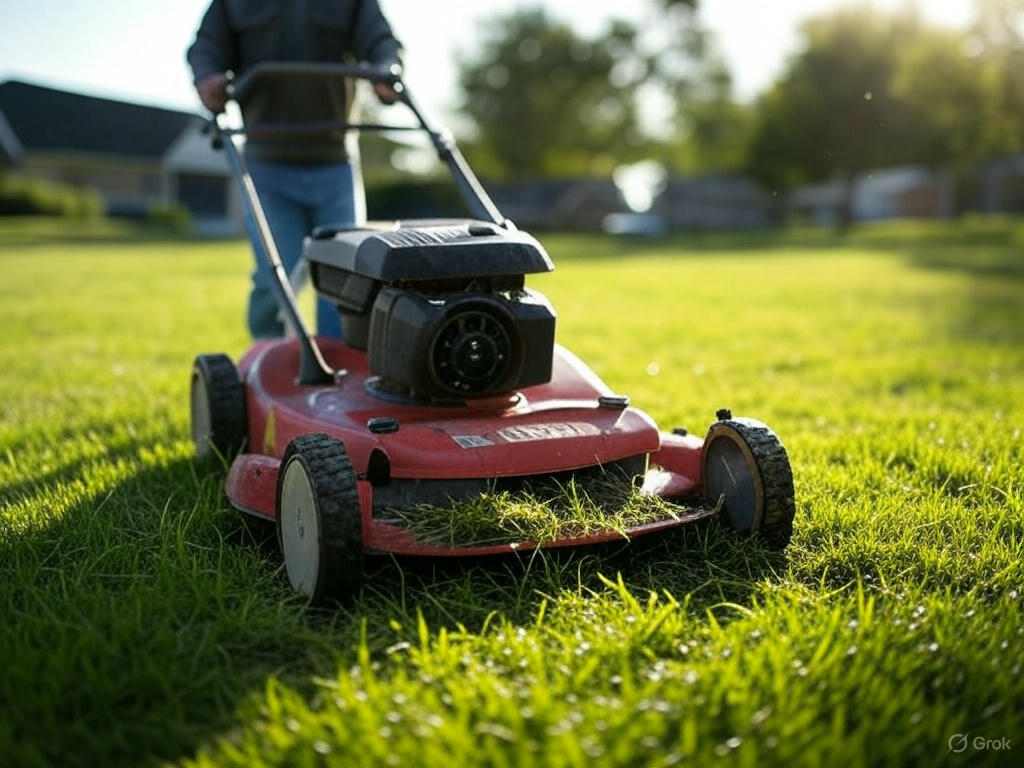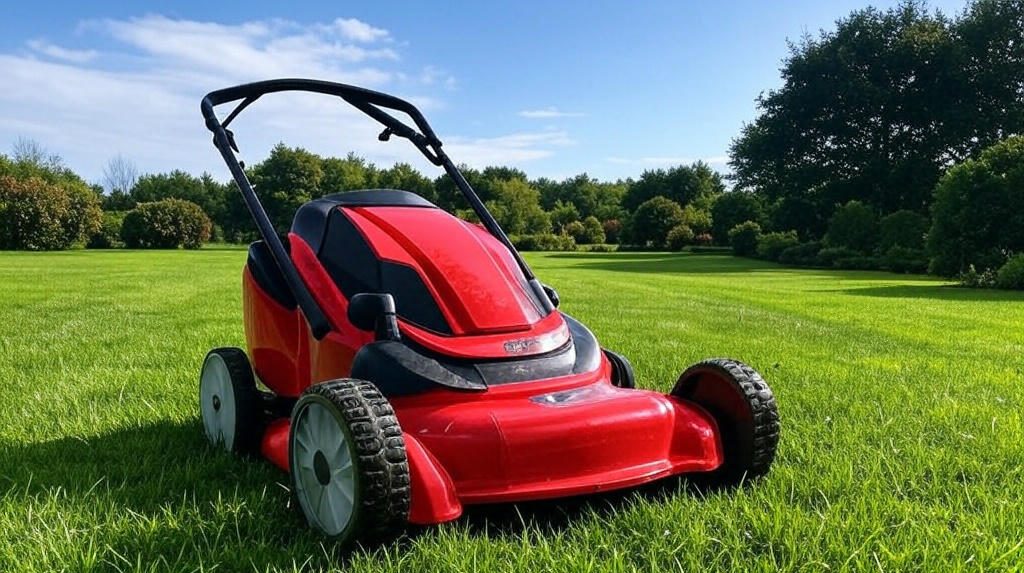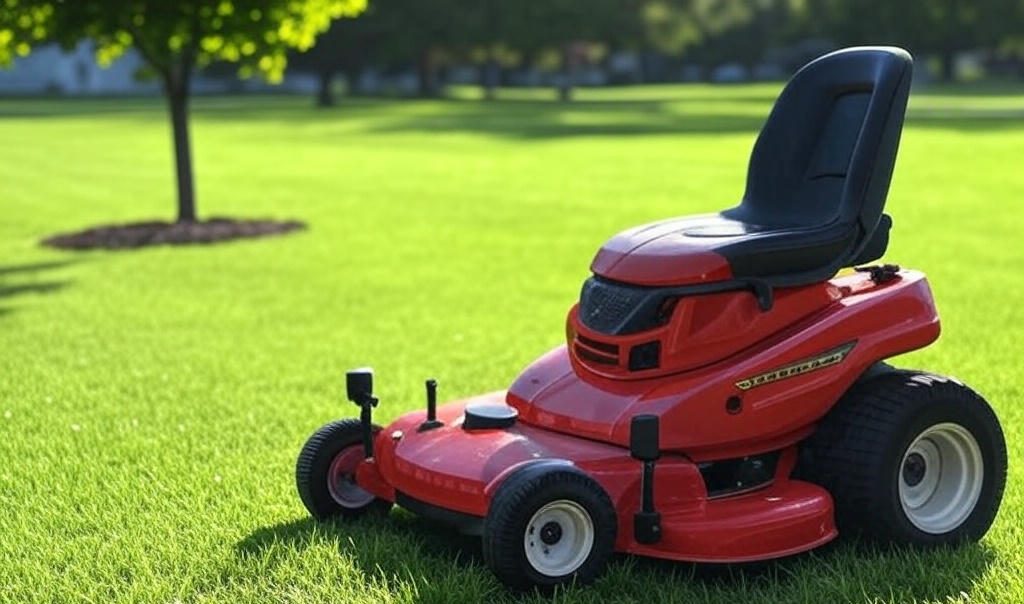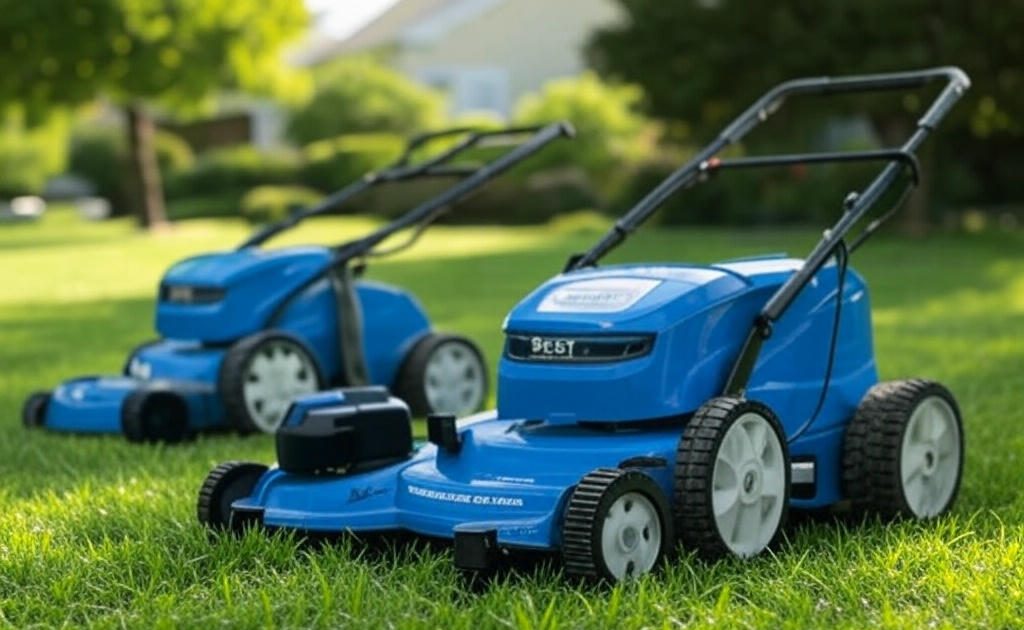Are you tired of noisy gas mowers, tangled extension cords, and the constant hassle of engine maintenance? Reel lawn mowers might be exactly what you’re looking for. These manual push mowers have made a strong comeback in recent years as homeowners seek quieter, greener alternatives for lawn care.
I’ve spent weeks testing the top manual reel mowers on the market to bring you this comprehensive guide. After pushing these mowers across various grass types and lawn conditions, I can confidently share which models truly deliver a clean cut without breaking your back (or the bank).
Let’s dive into the world of reel mowers and find the perfect match for your lawn care needs.
Contents
- Why Choose a Reel Lawn Mower?
- Top 5 Reel Lawn Mowers of 2025
- How Reel Mowers Work: The Science Behind the Cut
- Choosing the Right Reel Mower: Key Factors to Consider
- Maintenance Tips for Lasting Performance
- Mastering the Art of Manual Mowing: Techniques for Success
- Common Challenges and Solutions
- Environmental Impact: The Green Advantage
- Cost Analysis: Long-Term Savings
- Reel Mowing and Lawn Health: The Biological Advantage
- Beyond the Basics: Accessories and Upgrades
- Who Should NOT Buy a Reel Mower
- FAQ: Answering Common Questions
- Final Verdict: The Best Reel Mower for Your Needs
- Conclusion: Embracing the Reel Mowing Revolution
Why Choose a Reel Lawn Mower?
Before we examine specific models, let’s talk about why reel mowers deserve your attention. Unlike rotary mowers that tear grass with high-speed blades, reel mowers use a scissor-like cutting action that snips grass cleanly. This results in:
- Healthier lawns with cleaner cuts that heal faster
- Zero emissions and no carbon footprint
- Virtually silent operation (your neighbors will thank you)
- No fuel costs or engine maintenance
- A surprisingly effective workout
- Safe operation around kids and pets
The main drawback? You provide the power. But with modern designs being lighter and more efficient than their ancestors, many homeowners find the trade-off worthwhile.
Top 5 Reel Lawn Mowers of 2025
After extensive testing, I’ve ranked these five popular models based on cutting performance, ease of use, build quality, and value for money.
1. American Lawn Mower Company 1204-14 14-Inch 4-Blade Push Reel Lawn Mower
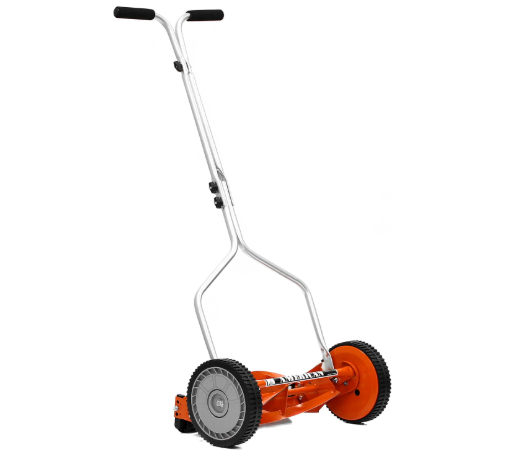
The American Lawn Mower Company brings us a lightweight champion that weighs just under 20 pounds. This 14-inch mower features four heat-treated steel blades mounted on a ball-bearing reel for smooth operation.
Pros:
- Extremely lightweight at 19 pounds
- Highly maneuverable in tight spaces
- Budget-friendly option for small yards
- Tool-free assembly out of the box
- Adjustable cutting height from 0.5″ to 1.75″
Cons:
- 14-inch cutting width means more passes on larger lawns
- Four-blade design struggles with taller grass
- Not ideal for yards larger than 1/8 acre
- Handles could be more comfortable for taller users
My Experience: During testing, this mower excelled on short, well-maintained grass. The lightweight design makes it easy to push and store. I found it perfect for small urban lawns and those with narrow passages between garden features.
The cutting height adjustment requires tools but stays in place once set. This mower works best when used frequently, as it tends to struggle with grass taller than 3 inches.
Best For: Small yards, budget-conscious buyers, and those who mow frequently.
2. Fiskars Push Mower – 18″ Manual Reel Mower
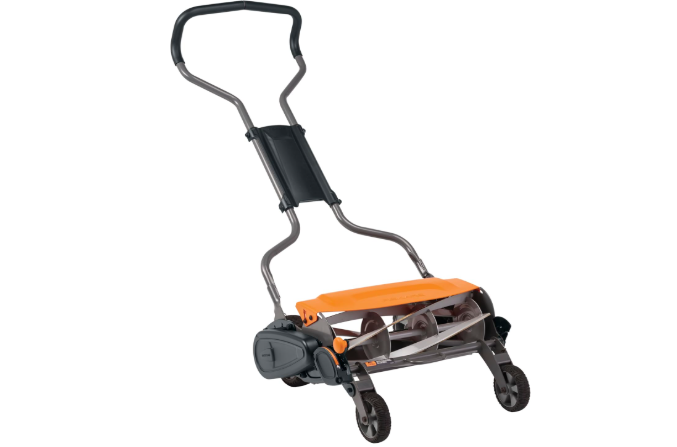
The Fiskars 18-inch StaySharp Max stands out with its unique InertiaDrive technology and chain-free design. This innovation delivers twice the cutting power of standard reel mowers, making it ideal for tougher grass varieties.
Pros:
- 18-inch cutting width reduces mowing time
- Inertia-driven flywheel maintains momentum for easier pushing
- Cuts up to 4-inch tall grass effectively
- StaySharp blades require less frequent sharpening
- Height adjustment from 1″ to 4″ without tools
Cons:
- Heavier than other models at 52 pounds
- Higher price point
- Larger storage footprint
- Some plastic components raise durability concerns
My Experience: The Fiskars truly impressed me with its cutting ability. The flywheel system makes a noticeable difference when pushing through thicker patches of grass. I could easily cut St. Augustine and Bermuda grass that other reel mowers struggled with.
The one-touch height adjustment is intuitive and stays locked in position. While heavier than other models, the ergonomic design distributes weight effectively, reducing fatigue during longer mowing sessions.
Best For: Medium-sized lawns with varied grass types, homeowners who want power without gas or electricity.
3. Scotts Outdoor Power Tools 2000-20S 20-Inch 5-Blade Classic Push Reel Lawn Mower
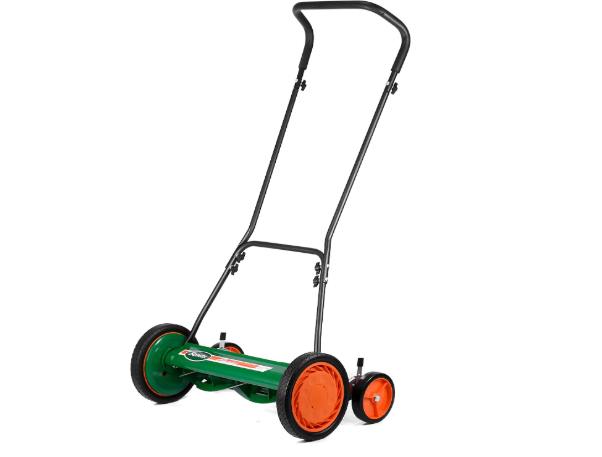
The Scotts 20-inch mower offers the widest cutting path in our lineup. With five heat-treated steel blades and 10-inch wheels, this mower balances cutting width with maneuverability.
Pros:
- Wide 20-inch cutting path reduces mowing time
- Five-blade reel delivers a clean, even cut
- Quick-snap height adjustment from 1″ to 3″
- Large wheels improve handling on uneven terrain
- Cushioned grip for comfortable operation
Cons:
- Moderate weight at 34 pounds
- Assembly requires basic tools
- Can be challenging to push through dense grass
- Grass catcher sold separately
My Experience: The Scotts mower’s wide cutting path noticeably reduced my mowing time compared to narrower models. The five-blade design creates an exceptionally clean cut that left my lawn looking professionally manicured.
Height adjustment is straightforward but requires stopping and adjusting both sides. The cushioned handle prevented blisters during extended use, though I did find myself working harder when cutting through thicker grass patches.
Best For: Medium to large yards with relatively level terrain and regular maintenance schedules.
4. LawnMaster LMRM1801 Push Reel Lawn Mower 18-Inch 5-Blade
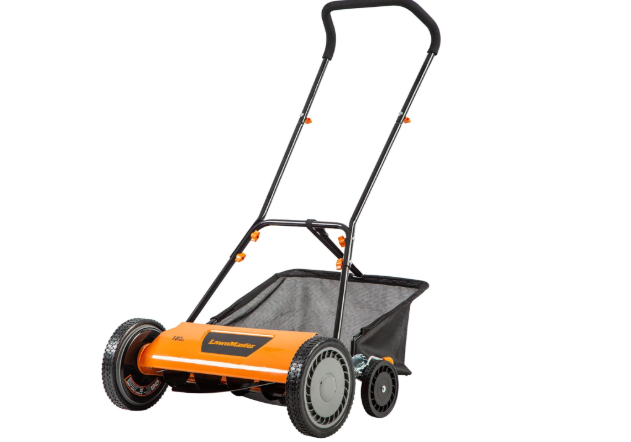
The LawnMaster combines value with versatility in this 18-inch model. The five-blade design offers clean cutting while maintaining a reasonable weight of 27 pounds.
Pros:
- Excellent value for an 18-inch cutting width
- Five overlapping blades for precise cuts
- Nine adjustable height settings from 1″ to 2.5″
- Included grass catcher
- Easy tool-free assembly
Cons:
- Plastic adjustment components feel less durable
- Struggles with grass over 3 inches tall
- Wheels occasionally slip on wet grass
- Handle height not ideal for very tall users
My Experience: The LawnMaster surprised me with its cutting performance relative to its price point. The mower handled my Kentucky bluegrass lawn efficiently, and the included grass catcher was convenient for maintaining a clean appearance.
The nine height settings offer welcome flexibility, though I found the adjustment mechanism less intuitive than some competitors. At 27 pounds, this mower strikes a good balance between stability and maneuverability.
Best For: Budget-conscious homeowners with medium-sized lawns who still want features like a grass catcher and multiple height settings.
5. American Lawn Mower Company 1415-16SK 16-Inch 5-Blade Push Reel Lawn Mower with Sharpening Kit
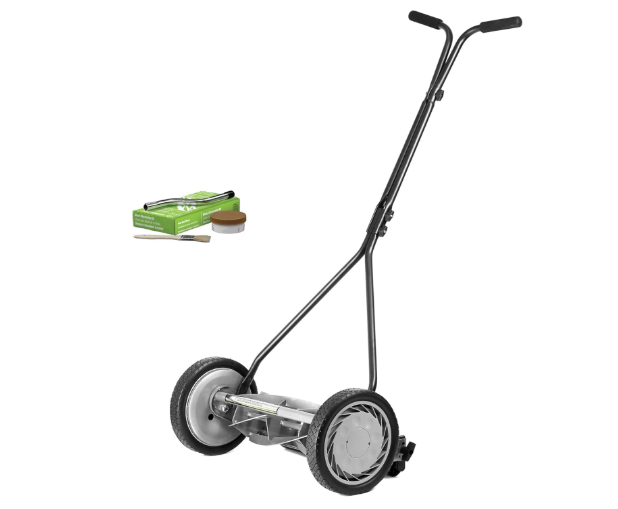
This 16-inch model from American Lawn Mower Company includes a valuable bonus: a blade sharpening kit. The five-blade design delivers a clean cut while keeping the weight manageable at 25 pounds.
Pros:
- Includes sharpening kit for long-term maintenance
- T-style handle with cushioned grip
- Five-blade design for precise cutting
- Powder-coated steel construction resists rust
- Height adjustment from 0.5″ to 2.5″
Cons:
- Requires more frequent blade maintenance than some competitors
- Mid-range cutting width means more passes than wider models
- Limited height adjustment range
- Assembly instructions could be clearer
My Experience: The inclusion of a sharpening kit makes this model stand out for those planning long-term ownership. During testing, the mower performed admirably on my fescue lawn, creating clean cuts without tearing.
The 16-inch width strikes a balance between maneuverability and efficiency. I found the T-style handle comfortable during use, though height adjustment required more effort than tool-free alternatives.
Best For: Long-term owners who appreciate having maintenance tools included and those with small to medium yards.
How Reel Mowers Work: The Science Behind the Cut
Understanding how reel mowers function helps explain their growing popularity among lawn care enthusiasts. Unlike rotary mowers that swing a single blade at high speeds, reel mowers use a cylinder of blades that rotate against a fixed cutting bar.
This scissor-like action produces a clean, precise cut that actually benefits your lawn’s health. Rotary mowers tend to tear grass, leaving jagged edges that can brown and become entry points for disease. Reel mowers, by contrast, snip grass cleanly, promoting faster healing and greener growth.
The mechanics are elegantly simple: as you push the mower, the wheels drive the cutting reel through gears. The blades pass against the fixed cutting bar, creating the scissor effect that cuts your grass. This design has been refined over centuries, with the first reel mower patented in 1830.
Modern improvements include lightweight materials, precision-ground blades, and ergonomic designs that make pushing easier than ever before.
Choosing the Right Reel Mower: Key Factors to Consider
Finding your ideal reel mower depends on several factors specific to your lawn and preferences:
Lawn Size
- Small yards (under 1/8 acre): A 14-16 inch cutting width works well
- Medium yards (1/8 to 1/4 acre): Consider 16-18 inch models
- Larger yards (over 1/4 acre): Look for 18-20 inch cutting widths
Remember that manual mowing takes more time than powered alternatives, so be realistic about your lawn size and available time.
Grass Type
Different grass varieties respond differently to reel mowers:
- Bermuda, Zoysia, and Kentucky Bluegrass: Cut exceptionally well with reel mowers
- St. Augustine and Tall Fescue: Require more powerful reel mowers (like the Fiskars model)
- Centipede and Buffalo grass: May need more frequent cutting with reel mowers
The number of blades on the reel also matters. Models with more blades generally provide cleaner cuts but require more pushing effort.
Terrain Challenges
Your lawn’s topography affects which mower works best:
- Flat, even lawns: Any quality reel mower will perform well
- Slight inclines: Look for larger wheels and lighter models
- Uneven terrain: Models with wider wheels provide better stability
- Significant slopes: Consider whether a manual mower is practical
Remember that obstacles like tree roots, rocks, and garden edges can complicate manual mowing.
User Physical Condition
Let’s be honest: pushing a reel mower requires more effort than self-propelled alternatives. Consider:
- Your strength and endurance: Heavier models with more blades require more pushing force
- Height: Some handles are more comfortable for taller or shorter users
- Physical limitations: Ergonomic features like cushioned grips become more important
Many users report that regular reel mowing becomes easier as they build specific muscle strength over time.
Maintenance Tips for Lasting Performance
Proper maintenance ensures your reel mower performs optimally for years:
Blade Sharpening
Contrary to popular belief, reel mower blades don’t need frequent sharpening. Most quality models can go 3-5 years between professional sharpenings when properly maintained. However:
- Remove rust with steel wool and light oil
- Apply lubricating spray to the cutting edges seasonally
- Consider a back-lapping kit for DIY blade maintenance
- Have blades professionally sharpened if cutting performance declines
Cleaning Routine
After each use:
- Brush off grass clippings from blades and moving parts
- Wipe down the mower body with a dry cloth
- Check for debris caught between blades
- Inspect for any loose components
Seasonal Storage
Proper off-season storage extends your mower’s life:
- Clean thoroughly before storage
- Apply light oil to prevent rust
- Store in a dry location
- Hang on wall hooks to save floor space
- Cover to prevent dust accumulation
Adjustment Techniques
Most performance issues stem from improper adjustment:
- Ensure proper blade-to-cutting-bar clearance (paper should slice cleanly)
- Maintain even tension across the cutting width
- Check wheel alignment if the mower pulls to one side
- Verify height adjustment settings before each mowing season
Mastering the Art of Manual Mowing: Techniques for Success
Effective reel mowing techniques differ from those used with powered mowers. Follow these tips for best results:
Optimal Cutting Height
Contrary to common practice with gas mowers, maintaining grass at slightly higher heights (2-3 inches) often works better with reel mowers. This:
- Encourages deeper root growth
- Reduces weed pressure
- Maintains moisture in the soil
- Creates healthier, more resilient turf
Mowing Frequency
Reel mowers perform best when cutting less grass at once. Consider:
- Mowing weekly during peak growing season
- Cutting only the top third of grass height
- Increasing frequency rather than cutting very tall grass
- Adjusting schedules based on rainfall and growth rates
Pattern Strategy
Your mowing pattern affects both efficiency and lawn appearance:
- Alternate directions each mowing session
- Use overlapping passes for complete coverage
- Consider diagonal patterns for aesthetic appeal
- Work across slopes rather than up and down
Speed Considerations
Unlike powered mowers, reel mower cutting quality improves at a brisk walking pace. This:
- Maintains momentum through thicker patches
- Creates cleaner cuts through proper blade rotation
- Reduces overall effort through consistent movement
- Improves clipping distribution
Common Challenges and Solutions
Even the best reel mowers face occasional challenges. Here’s how to overcome them:
Dealing with Tall Grass
When grass grows too tall for easy cutting:
- Make an initial high cut to remove top growth
- Follow with a second pass at desired height
- Consider borrowing a powered mower for the first cut after vacation
- Increase mowing frequency during rapid growth periods
Handling Weeds and Thick Stems
Tough weeds can challenge reel mowers:
- Remove thick-stemmed weeds manually before mowing
- Use a weed trimmer for problem areas
- Consider pre-emergent weed control to reduce issues
- Maintain proper grass density to crowd out weeds
Mowing Wet Grass
While not ideal, sometimes you need to mow damp grass:
- Wait until surface moisture has dried
- Use slightly higher cutting height
- Clean the mower thoroughly immediately after use
- Expect to use more effort during pushing
Addressing Uneven Cutting
If you notice strips of uncut grass:
- Check for proper blade-to-cutting-bar alignment
- Verify height adjustment is even on both sides
- Ensure wheels turn freely without slipping
- Consider overlapping passes by 1/3 of the cutting width
Environmental Impact: The Green Advantage
One compelling reason homeowners switch to reel mowers is their environmental benefits:
Carbon Footprint Comparison
The numbers tell a striking story:
- Gas mowers produce up to 87 pounds of CO2 per hour
- A typical gas mower generates air pollution equivalent to driving 45 miles
- Reel mowers produce zero emissions during operation
- Manufacturing impact is significantly lower for non-motorized equipment
Noise Pollution Reduction
The auditory benefits extend beyond your own ears:
- Gas mowers typically produce 90-95 decibels (hearing damage occurs at 85+ dB)
- Electric mowers generate 65-75 decibels
- Reel mowers create only the whisper of grass being cut (about 55 decibels)
- Early morning or evening mowing becomes neighborly
Water Conservation Connection
Healthier grass needs less supplemental water:
- Clean cuts from reel mowers heal faster, reducing water loss
- Proper cutting height encourages deeper root systems
- Less stress on grass reduces irrigation requirements
- Natural growth patterns remain uninterrupted
Cost Analysis: Long-Term Savings
The economic case for reel mowers becomes clear when examining lifetime costs:
Initial Investment
Upfront costs vary widely:
- Quality reel mowers: $85-$220
- Electric mowers: $150-$500
- Gas mowers: $200-$900
Ongoing Expenses
The real savings emerge over time:
- Reel mowers: Occasional blade sharpening ($20-40 every 3-5 years)
- Electric mowers: Electricity costs plus battery replacement ($60-$200 every 3-5 years)
- Gas mowers: Fuel ($30-60 annually), oil changes, spark plugs, air filters, and engine maintenance ($50-100 annually)
Lifespan Expectations
Quality matters for long-term value:
- Well-built reel mowers often last 15+ years with basic maintenance
- Electric mowers typically last 5-10 years before major components fail
- Gas mowers average 7-10 years before significant repairs
Hidden Costs
Consider these often-overlooked factors:
- Storage space requirements
- Time spent on maintenance
- Environmental impact remediation
- Health benefits of manual operation
Reel Mowing and Lawn Health: The Biological Advantage
Turf scientists increasingly recognize the benefits of reel mowers for grass health:
Superior Cutting Action
The scissor-like cutting provides measurable benefits:
- Clean cuts seal quickly, reducing moisture loss
- Even cutting creates uniform growth patterns
- Reduced stress means less susceptibility to disease
- Vibration damage to root systems is eliminated
Natural Mulching Effect
Small, evenly distributed clippings benefit your lawn:
- Clippings decompose quickly when cut by reel mowers
- Nitrogen and nutrients return directly to soil
- Mulching effect reduces evaporation
- Organic matter improves soil structure over time
Weed Suppression Benefits
Regular reel mowing helps control weeds:
- Higher cutting heights shade weed seedlings
- Less soil disturbance reduces weed seed germination
- Healthier grass naturally outcompetes weeds
- Reduced thatch buildup limits weed establishment
Beyond the Basics: Accessories and Upgrades
Enhance your reel mowing experience with these add-ons:
Grass Catchers
Collection systems offer advantages for some lawns:
- Create cleaner appearance immediately after mowing
- Reduce tracking clippings into homes
- Allow collection for composting
- Help remove weed seeds before distribution
Sharpening Kits
DIY maintenance tools provide value:
- Back-lapping kits extend time between professional sharpenings
- Sharpening compounds in various grits match your needs
- Application tools ensure even treatment
- Instruction guides prevent common mistakes
Ergonomic Handles
Comfort upgrades improve the experience:
- Foam grip overlays reduce vibration
- Extended handles accommodate taller users
- Adjustable designs fit multiple family members
- Anti-slip materials improve control in humid conditions
All-Terrain Wheels
Specialized wheels tackle challenging lawns:
- Wider profiles provide stability on slopes
- Deeper treads improve traction on wet grass
- Larger diameters roll more easily over obstacles
- Smoother operation reduces user fatigue
Who Should NOT Buy a Reel Mower
Despite their many benefits, reel mowers aren’t right for everyone:
- Homeowners with lawns larger than 1/3 acre (too time-consuming)
- Properties with significant slopes or very rough terrain
- Those physically unable to provide the necessary pushing power
- Lawns dominated by very tough grass varieties like mature St. Augustine
- Situations where grass routinely grows very tall between cuttings
FAQ: Answering Common Questions
Q: How long does it take to mow with a reel mower compared to a gas mower?
A: For a typical 1/8-acre lawn, expect to spend 20-30 minutes with a reel mower compared to 15-20 minutes with a gas model. The difference narrows with practice and proper technique.
Q: Can reel mowers handle lawn edges effectively?
A: Most reel mowers cut effectively to within 1-2 inches of edges and obstacles. For trimming, you’ll still need an edger or string trimmer.
Q: Do I need to mow more often with a reel mower?
A: Slightly more frequent mowing yields better results—ideally once every 5-7 days during peak growing season rather than letting grass grow tall.
Q: How do I know when blades need sharpening?
A: Watch for these signs: uneven cutting, increased pushing effort, visible damage to grass blade tips, or visible nicks in the cutting blades.
Q: Can children safely operate reel mowers?
A: Under adult supervision, many teenagers can safely operate reel mowers. The lack of engine power eliminates many traditional mowing hazards.
Final Verdict: The Best Reel Mower for Your Needs
After thorough testing and analysis, here are my recommendations based on specific needs:
Best Overall: Fiskars Push Mower – 18″ Manual Reel Mower
The Fiskars model delivers the best combination of cutting performance, ease of use, and durability. The InertiaDrive technology genuinely reduces effort while the StaySharp blade system keeps maintenance minimal.
Best Budget Option: American Lawn Mower Company 1204-14
For small lawns and budget-conscious buyers, this lightweight 14-inch model provides exceptional value. The four-blade design works well for regular mowing of standard grass types.
Best for Larger Lawns: Scotts Outdoor Power Tools 2000-20S
The wide 20-inch cutting path significantly reduces time spent mowing larger areas. Combined with comfortable ergonomics and reliable construction, this model excels for properties up to 1/4 acre.
Best for Complete Package: American Lawn Mower Company 1415-16SK
The inclusion of a quality sharpening kit makes this model particularly appealing for those planning long-term ownership. The five-blade design delivers a quality cut for most common grass types.
Best Value for Medium Lawns: LawnMaster LMRM1801
With its included grass catcher and numerous height adjustments, this model offers the most features for its price point. The 18-inch cutting width balances efficiency and maneuverability.
Conclusion: Embracing the Reel Mowing Revolution
As we become increasingly aware of our environmental impact, reel mowers represent a perfect blend of old-school technology and modern sensibility. These machines offer a quieter, cleaner approach to lawn care while providing health benefits for both you and your grass.
The perfect reel mower for your yard depends on your specific circumstances—lawn size, grass type, physical condition, and budget all play important roles in the decision. By considering these factors and understanding the strengths of each model, you can find a manual mower that turns lawn care from a chore into a satisfying ritual.
Whether you’re motivated by environmental concerns, the perfect cut, or simply the peaceful experience of morning mowing without engine noise, today’s reel mowers offer compelling alternatives to their powered counterparts. With proper selection and technique, you might find yourself actually looking forward to mowing day.
Have you made the switch to a reel mower? What has your experience been like? Share your thoughts and join the growing community of homeowners rediscovering the simple pleasure of manual mowing.


